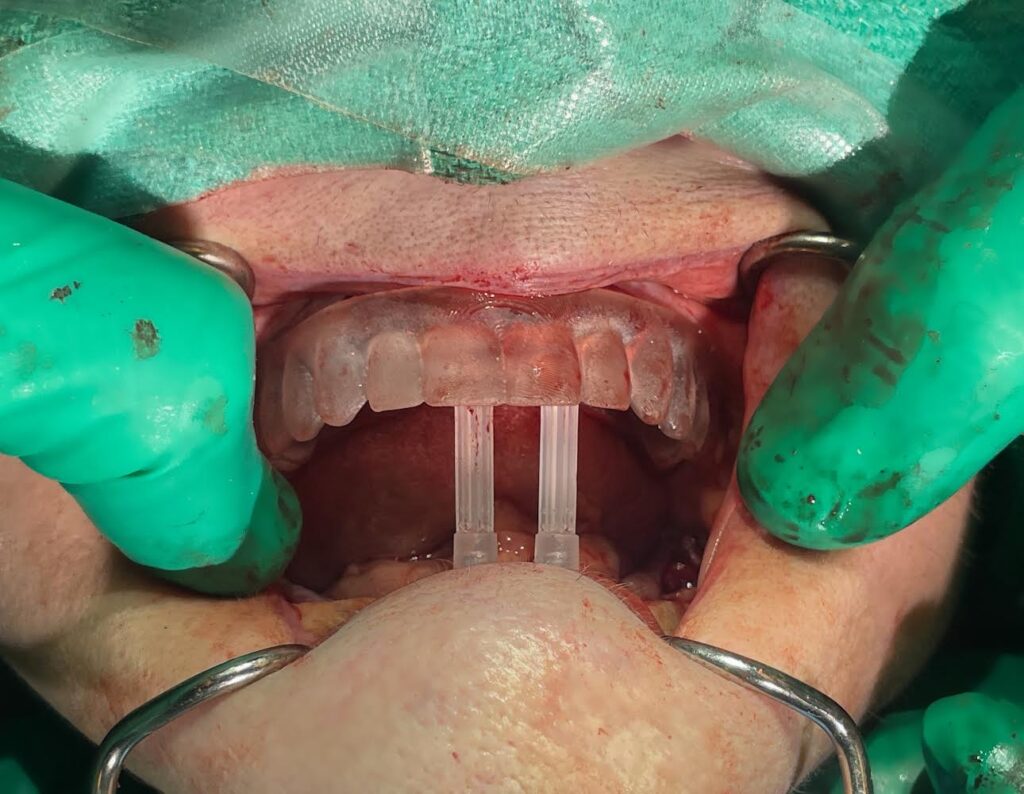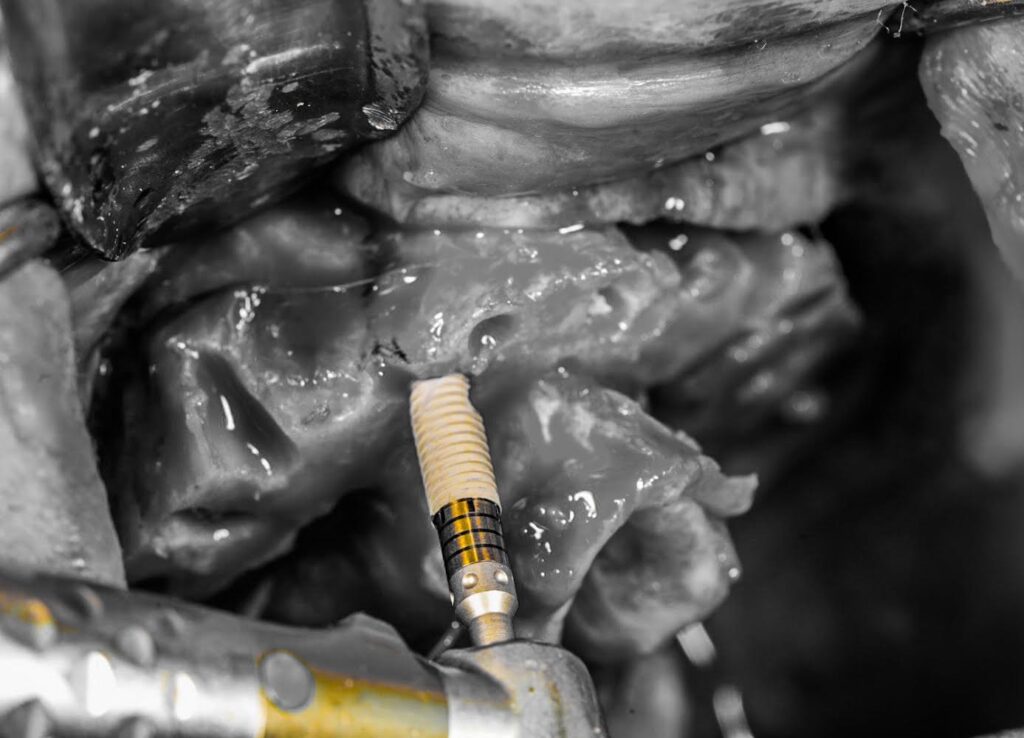Achieving clinically acceptable torque is critical to the consistent success of immediately loaded All-On-X surgeries.
In my experience achieving great torque… more than just the minimum clinically acceptable values, leads to a higher implant integration and fixed arch prosthetic success rate. While this is anecdotal, I am convinced this is the case.
So what is clinically acceptable torque?
Most practitioners in the AOX space will agree that you need a composite torque value (the sum of all the torques of your implants in that arch) of 120 N-cm or greater, in order to load a prosthetic.
An example of this is the statement from Drs. Jensen and Adams in regards to trans-sinus maxillary implants in an immediately loaded arch:
“If the 4-implant scheme has a composite insertion torque of 120 N-cm and vertical stability of all 4 implants is present, immediate function can be allowed.” ¹
So how much torque should each individual implant have?
If we accept the composite torque value of 120 N-cm or greater, each implant in the arch should average a torque of 30 N-cm or more, in order to immediately load.
So given that research shows us on average, 30 N-cm of individual implant torque for a 4-implant fixed arch prosthesis is adequate, should this be our goal?
It is not my goal. Nor do I think it should be yours.
I attempt to have each and every implant I place torque between 45-60 N-cm.
This is a composite torque of 180-240 N-cm.
Is this always possible…no. It’s not. But you will be surprised how often you can achieve this if you are consistently thinking of how to do so with each osteotomy and implant insertion.
And yes, there are times I have to accept a torque below 30. I would be lying if I didn’t say that was the case. But this is rare. If a torque below 30 is all I can achieve, I will employ other surgical techniques to improve the overall composite torque value to 120 N-cm or greater.

So why do I attempt to have each implant torque to a value of 45-60 N-cm, if 30 N-cm is clinically acceptable?
Here’s why:
1. I have more confidence in the restorative team handling the implants during the pick-up.
- I would like to think that everyone cares about the implants I just placed as much as I do. And that everyone handles them with as much tenderness and love…but that’s not always the case. Some people are heavier handed. Some people may forget which implant had a lower torque. And sometimes, accidents just happen.
- I am able to turn over my patient to the prosthetic team with more confidence and peace of mind when I know I have a solid torque value of 45-60 N-cm at each implant. It’s pretty difficult to accidentally dislodge or disrupt an implant at this torque value.
- If I do have an implant torqued at or below 30 N-cm, I record that implant in an easily visible place for the restorative team and ask that only the restorative doctor handle that implant – and that they do so with extra care.
2. Changing a straight abutment can loosen a low torque implant.
- The straight abutments I use are designed to be torqued to 32 N-cm.
- While it should not be common, there are times where your restorative provider may decide to change or rotate one of your implant abutments.
- If the restorative provider decides to change a straight abutment, during its removal a reverse torque of 32 N-cm or slightly greater will be applied. This can, and will, and has removed implants. This is obviously a significant risk, or inevitable, if your implant is torqued at less than 32 N-cm.
- I have had this happen to me. Thankfully only once. But it solidified in my mind the value of having a torque of greater than 30 N-cm, especially where straight abutments are placed.

3. I prefer higher torque to offset patient non-compliance.
- I know – and you know – that not all of our patients adhere to a soft diet for 4 months. I’d actually put money on the fact that maybe 25% of patients actually do a soft diet for the entire 4 month integration period.
- While higher implant torque is not a solution or cure for non-compliant patients, it sure helps me sleep better at night knowing that we have a solid, stable prosthesis should the patient step out of bounds slightly over that 4 month period.
4. I want solid torque, not just acceptable torque, on my posterior implants – especially if there is a cantilever.
- I feel that there is a higher failure rate when I have a lower torque implant as the distal implant in my prosthesis. While this is anecdotal, I am a firm believer in this principle. This is especially true if there is a cantilever and also in cases of even slight patient non-compliance.
- In this scenario, I either attempt to have all of my posterior implants torque in my target range, or I switch gears and add additional implants to remove the cantilever all together.
- I do think you can be a bit more lenient with this if you are moving immediately into a titanium bar prosthetic. If you are placing the patient in a temporary acrylic prosthetic, you have less protection and support for the lower torque posterior implant.
A few final thoughts…
- These target torque values are what I attempt to obtain. I do not always achieve these ideal scenarios. But I find I achieve them far more often when I am actively pursuing them.
- Severely atrophic cases are an exception to this rule. In cases with severe atrophy, I do attempt to achieve torque values closer to 30 N-cm. Attempting to achieve torque values much higher than this can cause fracture of the buccal plate, entire alveolus, or worse.
- No… I don’t see a higher failure rate with torque values above 60 N-cm. I have many, many implants that torque in the 60-80 N-cm range. In theory, compression necrosis could play a factor for implant failure at these values. I have yet to consistently see it with the implant system I use in the fixed arch setting.
- I do not, however, actively try to get a torque of higher than 60 N-cm. I do not find it anymore beneficial than being in the 45-60 N-cm range.
- Furthermore, once you start pushing above 60 N-cm of torque, you do need to be cautious that you do not fracture a driver off in the implant housing and/or damage the internal surface of the implant. That can and will happen if you push the limits too far. Unfortunately, I know this firsthand. In my experience, however, this component fracture will occur before a higher failure rate occurs due to increased torque and compression necrosis.
Barring extremes, in my opinion, more torque is better. There are simply too many positives to achieving more torque.
Here’s to not settling for 30…
Matthew Krieger DMD
References:
- Ole T. Jensen, DDS, MS, and Mark W. Adams, DDS, MS. Anterior Sinus Grafts for Angled Implant Placement for Severe Maxillary Atrophy as an Alternative to Zygomatic Implants for Full Arch Fixed Restoration: Technique and Report of 5 Cases. 2014 American Association of Oral and Maxillofacial Surgeons J Oral Maxillofac Surg 72:1268-1280, 2014.
Disclaimer:
Please know the recommended torque values for YOUR implant system.
Furthermore, this article is not written in any affiliation with an implant manufacturer or system – including the one I use. They may not agree with or recommend these torque values.
This is solely, an anecdotal article, based on personal clinical experience and opinion.
As your own practitioner, please use your own best judgment, your implant system/manufacturer recommendations, and your own surgical skill and experience.


Matt—well written! I always enjoy reading your posts!
Not sure if it’s a good thing, or bad that I find myself agreeing with almost everything you write! more torque is better than less—to a point. Cantilevers are not ideal, but sometimes we can “get away with it.” Patients lie.
Keep writing. I’ll keep reading!
Thanks Jeff!! I really appreciate the feedback and support!!
Pingback: Why I Check My Torque Value Once… Maybe Twice … But Never 11 Times! - AOX Surgery
Pingback: 3 Surgical Pearls for the Atrophic Jaw - AOX Surgery